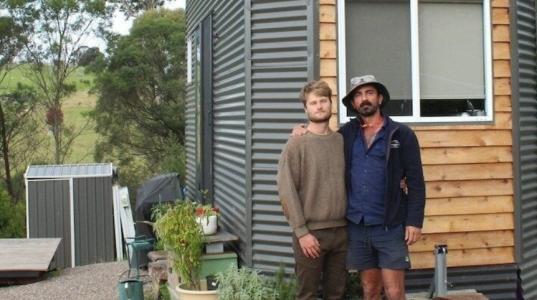'I don't have a place to stay': Couple faces dilemma and threats over their home
By
Danielle F.
- Replies 22
Living in a place one could call home could be a dream come true for many Australians.
Regardless of whether it's a sprawling estate or a tiny home that could house small families, homes should be a haven for people.
However, one couple has been facing a complicated predicament that sparked debates about home security in the country.
Manu Bohn and his partner found themselves priced out of the traditional property market.
With the devastation of the Black Summer bushfires and affordable housing options dwindling, the couple took matters into their own hands.
In 2023, the couple built a tiny house on a friend's farm on NSW's South Coast.
For two years, they enjoyed a 'simple and happy life of work, study, volunteering, and sport'.
However, the couple's peaceful life was shattered.
A letter from the Bega Valley Shire Council notified the couple about their 'unauthorised structure'.
The council stated their home had to be demolished or removed from their friend's property.
Otherwise, they would face legal action and a potential fine of up to $1 million, plus $10,000 for every day they remained.
Manu and his partner's story was far from unique.
Bega Valley has been grappling with a severe housing shortage.
Rent prices continue to soar, property prices have become out of reach for many, and more and more people have been turning to alternative living arrangements—tiny houses included.
Tiny homes could cost anywhere from $20,000 to $200,000.
Meanwhile, the median house price in Bega Valley has reached $630,000 as of April last year.
For Manu and his partner, their tiny house was 'basically the only affordable way of living'.
'If that's taken out of me, basically I'm just left with the tiny house—and that means, according to the letter, that I can't even park it anywhere,' Manu shared.
'So it means I don't have a place to stay.'
One of the biggest challenges tiny house owners have faced over the years was the lack of clear definitions and pathways.
In NSW, there's no fixed definition of a tiny home under the planning framework.
Depending on how it's built and used, a tiny house could be classified as anything from a granny flat to a caravan.
Emily Harrison, Bega Valley Shire Council's Director of Community, Environment and Planning, explained that using land as a dwelling often required approval.
These approvals often include a Development Application (DA) lodged in accordance with the Environmental Planning and Assessment Act 1979.
This process should ensure health, safety, and environmental standards are met, including fire safety, waste disposal, and vegetation management.
Manu and his partner did not seek council permission or a DA.
'Our understanding was and still is that our tiny house built on wheels is considered a mobile dwelling under NSW legislation, which doesn't require a DA and allows us to move it to maybe our own future land,' Manu clarified.
However, the council saw things differently, and the lack of a DA meant they could not be sure the necessary standards had been met.
While the council itself cannot impose a $1 million fine, the Land and Environment Court could do so should the matter go too far.
After receiving the council's letter, Manu launched a petition calling for a moratorium on tiny house evictions.
He also urged the council to work with the NSW Government to create a legal pathway for tiny home ownership.
'A viable solution to the housing crisis is not only being ignored but fought against,' the petition read.
Manu also pointed out that many people, including seniors and those in vulnerable situations, have turned to tiny homes as a last resort.
For seniors, tiny homes offer a way to downsize, reduce living costs, and maintain independence without the burden of a mortgage or rent.
Councils across Australia have been grappling with how to balance affordable housing with concerns about safety and sanitation.

Have you considered a tiny home, or do you know someone who has? What do you think of Manu's situation? We would love to read your thoughts and opinions about this story in the comments below!
Regardless of whether it's a sprawling estate or a tiny home that could house small families, homes should be a haven for people.
However, one couple has been facing a complicated predicament that sparked debates about home security in the country.
Manu Bohn and his partner found themselves priced out of the traditional property market.
With the devastation of the Black Summer bushfires and affordable housing options dwindling, the couple took matters into their own hands.
In 2023, the couple built a tiny house on a friend's farm on NSW's South Coast.
For two years, they enjoyed a 'simple and happy life of work, study, volunteering, and sport'.
However, the couple's peaceful life was shattered.
A letter from the Bega Valley Shire Council notified the couple about their 'unauthorised structure'.
The council stated their home had to be demolished or removed from their friend's property.
Otherwise, they would face legal action and a potential fine of up to $1 million, plus $10,000 for every day they remained.
Manu and his partner's story was far from unique.
Bega Valley has been grappling with a severe housing shortage.
Rent prices continue to soar, property prices have become out of reach for many, and more and more people have been turning to alternative living arrangements—tiny houses included.
Tiny homes could cost anywhere from $20,000 to $200,000.
Meanwhile, the median house price in Bega Valley has reached $630,000 as of April last year.
For Manu and his partner, their tiny house was 'basically the only affordable way of living'.
'If that's taken out of me, basically I'm just left with the tiny house—and that means, according to the letter, that I can't even park it anywhere,' Manu shared.
'So it means I don't have a place to stay.'
One of the biggest challenges tiny house owners have faced over the years was the lack of clear definitions and pathways.
In NSW, there's no fixed definition of a tiny home under the planning framework.
Depending on how it's built and used, a tiny house could be classified as anything from a granny flat to a caravan.
Emily Harrison, Bega Valley Shire Council's Director of Community, Environment and Planning, explained that using land as a dwelling often required approval.
These approvals often include a Development Application (DA) lodged in accordance with the Environmental Planning and Assessment Act 1979.
This process should ensure health, safety, and environmental standards are met, including fire safety, waste disposal, and vegetation management.
Manu and his partner did not seek council permission or a DA.
'Our understanding was and still is that our tiny house built on wheels is considered a mobile dwelling under NSW legislation, which doesn't require a DA and allows us to move it to maybe our own future land,' Manu clarified.
However, the council saw things differently, and the lack of a DA meant they could not be sure the necessary standards had been met.
While the council itself cannot impose a $1 million fine, the Land and Environment Court could do so should the matter go too far.
After receiving the council's letter, Manu launched a petition calling for a moratorium on tiny house evictions.
He also urged the council to work with the NSW Government to create a legal pathway for tiny home ownership.
'A viable solution to the housing crisis is not only being ignored but fought against,' the petition read.
Manu also pointed out that many people, including seniors and those in vulnerable situations, have turned to tiny homes as a last resort.
For seniors, tiny homes offer a way to downsize, reduce living costs, and maintain independence without the burden of a mortgage or rent.
Councils across Australia have been grappling with how to balance affordable housing with concerns about safety and sanitation.
Key Takeaways
- A couple living in a tiny house has been ordered by the local council to demolish their home or face legal action and a possible fine.
- The couple built their tiny house due to being priced out of the housing market.
- The couple argued that their tiny house on wheels should be considered a mobile dwelling under NSW legislation.
- The case highlighted the lack of clear regulations for tiny homes in NSW and has sparked calls for council and government action to create pathways for legal tiny home ownership.








